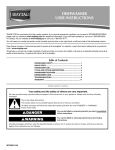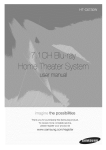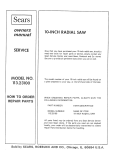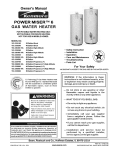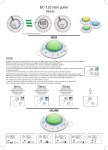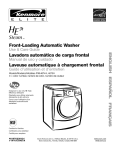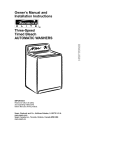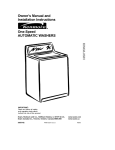Download Kenmore 2220695 Refrigerator User Manual
Transcript
Owner's
Manual
and
installation instructions
Three-Speed
AUTOMATIC WASHERS
IMPORTANT:
Your washer may look different
from the washer shown.
Read and follow all safety
and operating
instructions
before first use of this product,
Sears,
Roebuck
PART NO. 3950144
and
Co.,
Rev. A
Hoffman
Estates,
PRINTED
IL 60179
IN U.S.A.
U.S.A.
BEFORE USING YOUR NEW WASHER
2
SEARS AUTOMATIC WASHER WARRANTY
3
iMPORTANT
4
SAFETY iNSTRUCTiONS
iNSTALLATION
iNSTRUCTiONS
OPERATING YOUR WASHER
20
LAUNDRY TiPS
29
CARING FOR YOUR WASHER
31
TROUBLESHOOTING
32
SEARS MAINTENANCE
AGREEMENT
Please read this manual.
It will help
you install and operate your new
Kenmore
washer in the safest and
most economical
For more
5
36
Use the space below to record the model
number and serial number of your new
Kenmore
Washer.
way.
information
about
the care
and operation
of Kenmore
appliances
call your nearest Sears store. You will
need the complete
model and serial
numbers when requesting
information.
Your washer's
model and serial numbers
are located on the Model and Serial
Number Plate.
ModelandSerial
NumberPlate
Model No.
Serial
No.
Date of Purchase
Keep this book and your Sears
Salescheck
(receipt)
in a safe
place for future
reference.
FULLI-YEAR
WARRANTY
ON MECHANICAL
AND
ELECTRICAL
PARTS
LIMITED
10-YEAR
ON PLASTIC
TUB
WARRANTY
After one year and until
date of purchase,
Sears
replacement
plastic tub
tub which is defective
in
For one year from the date of purchase,
when the washer is installed and operated
in accordance
with the instructions
in
ten years from
will furnish a
for any plastic
material or work-
the Owner's
Manual, Sears will repair or
replace any mechanical
or electrical parts
in this washer, if defective
in material
or
workmanship.
manship.
LiMiTED 5-YEAR WARRANTY
ON GEARCASE
PARTS
WARRANTY
SERVICE
IS AVAILABLE
BY CONTACTING
THE NEAREST
SEARS SERVICE
CENTER
IN THE
UNITED STATES.
After one year and until five years from
the date of purchase,
Sears will furnish
replacement
parts for any defective
gearcase parts. You will be charged for labor.
You will be charged
If the washer is subjected
to other than
private family use, the above warranty
coverage
is effective
for only 90 days.
This warranty
applies only while this
product is in use in the United States.
This warranty
gives you specific legal
rights, and you may also have other
rights which vary from state to state.
Sears, Roebuck
and
Hoffman
Estates,
IL
Your safety and the safety
for labor.
of others
We have provided
many important
safety
and on your appliance.
Always
read and
is very
Co., Dept.
60179.
817WA,
important.
messages
in this manual
obey all safety messages.
This is the safety alert symbol.
This symbol
alerts
you to hazards
that can kill or hurt you and others.
A!l safety messages
will be preceded
by the safety
alert symbol
and the word "DANGER"
or "WARNING."
These words mean:
injured
youkilled
don'tor follow
You will ifbe
seriously
instructions.
injuredcan ifbe
youkilled
don't or follow
You
seriously
instructions,
All safety messages
will identify the hazard, tell you how to reduce
the
chance
of injury, and tell you what can happen
if the instructions
are
not followed.
YOUR SAFETY IS IMPORTANT TO US
WARNING:
To reduce the risk of fire,
electric shock, or injury to persons
when using your washer, follow basic
precautions,
including the following:
• Read all instructions
the washer.
• Do not wash articles
before
using
that have been
previously cleaned in, washed in, soaked
in, or spotted with gasoline, dry-cleaning
solvents, other flammable
or explosive
substances
as they give off vapors that
could ignite or explode.
• Do not add gasoline, dry-cleaning
solvents, or other flammable or explosive
substances
to the wash water. These
substances
give off vapors
ignite or explode.
that could
washing machine, turn on all hot water
faucets and let the water flow from each
for several minutes. This will release any
accumulated
hydrogen gas. As the gas is
flammable,
do not smoke or use an open
flame during this time.
• Do not allow children to play on or in
the washer. Close supervision
of children
is necessary when the washer is used
near children.
• Before
service
the washer
or agitator
• Do not install
Observe
if the tub
or store this washer
with controls.
• Do not repair or replace any part
washer or attempt any servicing
specifically
recommended
in the
Manual or in published user-repair
instructions
that you understand
have the skills to carry out.
all governing
codes
where
to the weather.
SAVE THESE INSTRUCTIONS
IMPORTANT:
from
the lid.
is moving.
• Do not tamper
If the hot water system has not been
used for such a period, before using a
remove
• Do not reach into the washer
it will be exposed
• Under certain conditions,
hydrogen gas
may be produced in a hot water system
that has not been used for 2 weeks or
more. HYDROGEN
GAS IS EXPLOSIVE.
is removed
or discarded,
and ordinances.
of the
unless
Owner's
and
INSTALLATION
OVERVIEW
For a complete
list of tools
needed,
see pages 6-8.
A. SELECT
LOCATION
FOR YOUR WASHER
Recessed Areal
Closet
Installation
Standpipe
39"
and parts
Drain
(pgs.
10-12)
Laundry
Instructions
System
Tub Drain
System
(p. 10)
(p. 12)
Floor
Drain
System
(p. 12)
(p. 11)
B. REMOVE SHIPPING
STRAP (p. 13)
Tools Needed:
Scissors
C. CONNECT
Flashlight (optional
depending on installation)
DRAIN
HOSE
(pgs.
i4-i5)
__/TWl
_,_Yl
_ _i
Tools
Needed:
Parts
ST
/ AND
PUSH
Needed:
Pliers that open
to I9/_6 inches
Flashlight (optional
depending on installation)
I yellow, single-wire
hose clamp (top of
drain hose)
1 silver, doublewire hose clamp
(bottom of drain
hose)
D, CONNECT iNLET HOSES TO WASHER (pgs. 15-16)
1
Tools
Needed:
Parts
Needed:
Su
2 water inlet hoses
Pliers that open
to 19/[_inches
Flashlight (optional
depending on installation)
4 flat water inlet hose washers
E. CONNECT INLET HOSES TO WATER FAUCETS (p, 16)
Tools
Needed:
Parts
Needed:
2 water inlet hoses
9
Pliers that open to 1 /_6inches
(optional
depending on
installation)
Flashlight (optional
depending on installation)
F. SECURE DRAIN HOSE (p. 17)
Tools
Needed:
Parts
Flashlight (optional
depending on installation)
G. LEVELWASHER
Tools
Needed:
Shipping strap with fastener
(p, 18)
Needed:
Parts
Needed:
U16-1nch
open-end wrench
2 front leveling legs with nuts
Flashlight (optional
depending on installation)
Wood block
Selecting
the proper
location
for your
washer
will improve
its performance
and minimize
concerns
like washer
walk or noise.
ELECTRICAL
REQUIREMENTS
120-Volt, 60-Hz., AC-only,
15- or
20-ampere
fused electrical supply is
required.
(Time-delay
fuse or circuit
breaker is recommended.)
Connect
to
individual
branch circuit.
GROUNDING
INSTRUCTIONS
WARNING:
improper
connection
of
the equipment
grounding
conductor
can
result in a risk of electric shock. Check
with a qualified
electrician
or serviceman
if you are in doubt as to whether
the
appliance
is properly
grounded.
Do not
modify the plug provided with the appliance - if it will not fit the outlet, have
a proper outlet installed by a qualified
electrician.
For your personal safety, this washer
must be grounded,
in the event of
malfunction
or breakdown,
grounding
wiii reduce the risk of electric shock
Electrical
Plug into
outlet.
Shock
a grounded
Hazard
3-prong
Do not
remove
ground
Do not
use an adapter.
Do not
use an extension
Failure
to follow
these
can result
in death,
electrical
shock.
fire,
prong.
cord.
instructions
or
by providing
a path of least
for electric current.
resistance
This washer is equipped
with a power
supply cord having a 3-prong grounding
plug. To minimize possible shock hazard,
you must plug the power supply cord
into a mating 3-prong
grounding-type
wall receptacle,
grounded
in accordance
with National Electrical Code, ANSl/NFPA
70-latest
edition and all local codes and
ordinances.
3-prong
grounding-type
wail receptacle
3-prong
grounding
plug
©
Grounding
prong
Power
supply
\
I11
//
A. SELECT LOCATION
FOR YOUR WASHER RECESSED
AREAl
CLOSET INSTALLATION
INSTRUCTIONS
This washer may be installed in a recessed area or closet.
3"
f
48 sq. in.
minimum
ventilation
area
24 sq. in.
minimum
ventilutiun
3"
al'ea
FrontView
(DoorWith Vent)
*Additionalclearancetot wall, door and tloor moldings may be required.
Toreducetransferof washersounds, a clearanceot 1 inchon the sidesot the washeris recommended.
• The installation
spacing is in inches
and is the minimum
allowable.
• Allow additional
space if other appliances are to be installed in the area.
I0
• if closet
door is installed,
the mini-
mum air openings
in top and bottom
are required.
Louvered
doors with
equivalent
air openings
in top and
bottom are acceptable.
LAUNDRY TUB DRAIN SYSTEM
Check location where
installed. This washer
using
one of three
• Laundry
• Floor
systems:
tub drain
• Standpipe
drain
drain
washer will be
can be installed
system
system
system
(below)
(p. 12)
(p. 12)
Grounded receptacle:
Must
be within 4 feet of where the
power cord is attached to the
back of the washer.
Do not store or operate washer at or
below 32°F (some water may remain in
washer).
See page 31 for Winterizing
Information.
Proper installation
is your responsibility.
Make sure you have everything
necessary
for correct
installation
including
the
following
points:
Hot and cold water faucets:
Must provide water pressure
between 5-100 psi and be
within 4 feet of the hot and
cold water fill valves attached
to the back of the washer.
Laundry tub drain system:
Needs a minimum 20-gallon
laundry tub.
Support:
Floor must be sturdy
enough to support a total weight
of 315 pounds (including washer,
water, and load weight).
Level floor:
Maximum
allowable slope under entire
washerI inch.
Top of tub must be at
least 39 inches above
floor and no higher
than 96 inches from
bottom of washer.
I1
ALTERNATE LOCATIONSSTANDPIPE AND FLOOR DRAIN SYSTEMS
Siphon break: Must be purchased
separately. See chart below.
Standpipe drain system: Needs a two-inch
minimum diameter standpipe with minimum
carry-away capacity of 17 gallons per minute.
Top of standpipe must be at least 39 inches
above floor and no higher than 96 inches
from bottom of washer.
If you
have:
Floor drain system: Requires a siphon
break, see chart below. A minimum carryaway capacity of 17 gallons per minute
is required.
You will
need
to buy:
Laundry tub or standpipe
taller than 96 inches
Sump pump system
(if not already available)
1-inch
2-inch diameter
to 1-inch diameter
standpipe
adapter, Part No. 3363920
diameter
Overhead
Floor
drain
sewer
standpipe
Standard
20 gallon, 39-inch tall drain
tub or utility sink and sump pump
(available from local plumbing
suppliers)
Siphon break, Part No. 285320;
additional
drain hose, Part No. 3357090;
and Connector
Kit, Part No. 285442
Parts listed are available from your local Sears store or Sears Service Center.
Call 1-800-366-PART (1-800-366-7278).
I2
B. REMOVE SHIPPING STRAP
Removing
the shipping
strap is
necessary
for smooth
operation,
If the shipping
strap is not
removed,
the washer
will make
excessive
noise.
To prevent
cardboard
STEP 3. Pull firmly to remove the
end of the shipping strap that remains
pinned to the back of the washer. This
will release the rear self-leveling
legs.
floor damage, set washer onto
before moving across floor.
Move washer
close
to its final
location.
STEP 1. Read, then remove the label
over the electrical plug and shipping strap.
STEP 2. Pull the yellow shipping
strap
completely
out of the washer. There
should be three cotter pins on the end
of the shipping
strap when it is pulled
out of the washer. The electrical plug is
attached to this shipping strap.
\
PULL
STEP 4. Cut the shipping
strap about
16 inches from plug end. Look for the
words "CUT HERE;' Discard end with
Electrical plug
three cotter pins. Slide remainder
of
shipping
strap from the electrical
plug. You will use this to secure the
drain hose.
ipplng s rap
Pin
I3
C. CONNECT DRAIN HOSE
Proper
connection
of the drain hose
will protect
your floors
from damage
due to water leakage.
STEP 1. To prevent the drain
coming off or leaking, it must
per the following
instructions:
hose from
be installed
IMPORTANT:
To ensure proper installation, this procedure
must be followed
exactly.
a. Wet the inside of the straight end of
the drain hose with tap water. DO
NOT USE ANY OTHER
LUBRICANT.
b. Squeeze ears of silver, double-wire
clamp with pliers to open. Place clamp
over the straight end of the drain hose
1/4 inch from the end.
d. Place clamp over
"CLAMR"
Release
1/4'_
area marked
clamp.
DrainHnsex
c. Open clamp. Twist hose back and
forth while pushing down onto drain
connector
at the bottom of the washer.
Continue
until hose contacts
the
ribbed
stop on the cabinet.
If you
have:
You will
Drain
hose that is too short
Drain hose, Part No. 388423
hose kit, Part No. 285442
Drain
hose that is too long
Hose
kit, Part No. 285442
Drain
protector,
A problem
with lint clogging
your drain
need
to buy:
Part
No. 367031
Parts listed are available from your local Sears store or Sears Service Center.
Call 1-800-366-PART (1-800-366-7278).
I4
and
Forstandpipe
or laundrytubdrain
systems:
STEP2.Openyellow,single-wire
clamp
withpliersandslideoverhooked
end
ofdrainhosetosecure
therubber
and
corrugated
sections
together.
Hooked
End
D. CONNECT INLET HOSES
TOWASHER
Proper connection
will allow hot and
your washer
properly,
prevent water damage
Slip
and Fall
Use new water
Failure
STEP
3. Put hooked
end of drain
hose
into laundry tub or standpipe.
Check
for proper length of drain hose. Rotate
hook to eliminate
kinks.
To prevent drain
into the washer:
water
from
going
back
• Do not straighten
hooked end of drain
hose and force excess drain hose into
standpipe.
• Do not lay excess
of laundry tub.
drain
hose in bottom
of your inlet hoses
cold water to enter
injury
it also helps
due to leaks.
Hazard
inlet hoses.
to do so can
or broken
result
in head
bones.
NOTE: Replace inlet hoses after five
years of use to reduce the risk of hose
failure. Periodically
inspect and replace
inlet hoses if bulges, kinks, cuts, wear,
or leaks are found. When replacing
your inlet hoses, mark the date of
replacement
on the label with a
permanent
marker.
STEP 1. Insert one new, flat washer
(from the parts bag) into each end of
the inlet hoses. Check that washers
are firmly
seated
COUPLING
in couplings.
WASHER
I5
STEP2.Attachthehosewiththered
coupling
tothehotwater(bottom)
inlet
valve.
Attaching
theredcoupling
first
makesiteasier to tighten connection
E. CONNECT INLET HOSES
TO WATER FAUCETS
with pliers. Screw on coupling
Make an additional
two-thirds
empty. Run water through both faucets
into a bucket or laundry tub to get rid of
particles
in the water lines that might
clog hoses. Determine
which faucet is
hot and which is cold. Mark the hot water
faucet.
pliers to tighten
OVERTIGHTEN;
the valves.
by hand.
turn with
coupling.
DO NOT
this could damage
Cold Water
inlet Valve
STEP
1. Make
sure washer
basket
is
Hot
Water
Inlet
Valve
STEP
STEP
3. Attach
the hose with the blue
coupling
to the cold water (top) inlet
valve. Screw on coupling by hand. Make
an additional
two-thirds
turn with pliers
to tighten coupling.
DO NOT OVERTIGHTEN;
this could damage valves.
2. Attach
STEP
STEP
check
3. Attach
have:
the hose with
the blue
coupling.
DO NOT
this could damage
You will
need
the washer.
You will
to buy:
2 longer water fill hoses: 6 ft. hoses,
Part No. 76314 or 10 ft. hoses,
Part No. 350008
Parts listed are available from your local Sears store or Sears Service Center.
Call 1-800-366-PART (1-880-366-7278).
I6
the red
4. Turn on water faucets and
for leaks. A small amount of
water may enter
drain this later.
Water faucets beyond the
reach of water fill hoses
hose with
coupling
to the cold water faucet.
Screw on coupling to faucet by hand.
Make an additional
two-thirds
turn with
pliers to tighten
OVERTIGHTEN;
the coupling.
If you
the
coupling
to the hot water faucet. Screw
on coupling
by hand. Make an additional
two-thirds
turn with pliers to tighten
coupling.
DO NOT OVERTIGHTEN;
this could damage the coupling.
F. SECURE DRAIN HOSE
Securing
the drain
protect
your floors
to water leakage.
hose
from
STEP 1. Move washer
location.
properly
damage
will
due
to its final
If the water faucets and drain standpipe
are recessed,
put hooked end of drain
hose in standpipe.
Tightly wrap the
shipping
strap around the drain hose
and water inlet hoses (not the handles
or stems). Push fastener
into the
nearest hole in the shipping
strap.
-4
u
STEP 2. Locate the remaining
piece
of sMpping
strap (not the end with the
three cotter pins) from STEP 4 of
"REMOVE
SHIPPING
STRAP." Use
it to wrap the drain hose together with
the laundry tub or standpipe.
Push
fastener
into the nearest hole in the
shipping
strap.
Fastener
I7
G. LEVEL WASHER
Leveling
your washer
properly
prevents excessive
noise and vibration.
To install
front
legs:
STEP 1. Prop front of washer up (about
4 inches). Use a wood block or another
object that will support the weight of the
washer. If washer was placed against
a wall, move the washer out slightly
before tipping it up.
STEP
screw
of leg
initial
2. With one of the legs in hand,
lock nut onto leg 3/8 inch from top
base. This is the recommended
setting.
STEP 3. Screw leg into washer
hand until nut reaches washer
Repeat
for other
base by
base.
leg.
STEP 5. Move washer
location.
to its final
STEP 6. Tilt washer forward
until rear
of washer is at least 3 inches off floor.
You may hear the self-adjusting
rear
legs click into place. Lower washer to
floor. Check levelness
of the washer
by placing a level on top of the washer,
first side-to-side;
then front-to-back.
STEP 7. If washer is not level, prop
up the front of the washer and adjust
the legs up or down as necessary.
Lower
washer and reset self-adjusting
rear legs
(as in Step 6). Repeat Step 7 until
the washer is level.
STEP
8. When
washer
is in its final
location and level, use a 9/16-inch openend wrench to turn nuts on front legs
tightly against washer cabinet. If nuts
are not tight against washer cabinet,
the washer may vibrate.
STEP 4. Tilt washer backward
front of washer is off the wood
Remove wood block.
washer to floor.
I8
Gently
until
block.
lower
REVIEW INSTALLATION
Take a few minutes
to complete
this checklist,
it will help assure
you
that you have a proper installation
and increase
your satisfaction
with
your Kenmore
washer,
[]
[]
Check electrical
requirements.
Be sure you have correct electrical
supply and recommended
grounding
method.
[]
Check
[]
Check
turned
[]
Take a few minutes
that you have:
• All the tools
• Removed
you started
• Removed
shipping
three cotter pins.
• Installed all parts
pages 6-8.
that:
• The washer
is level.
• The nuts on the front
with.
all packaging
Check
that the water
on.
legs are tight.
faucets
are
materials.
strap
with
listed
on
cord
into
FINAL STEPS
[]
[]
Plug power supply
grounded
outlet.
Remove the blue protective
film on
the console and any tape remaining
on washer.
and read the
Operating instructions
(pages 20-28)
to fully understand
your new washer.
Then, start the washer and allow it to
complete
the ULTRA CLEAN Cycle.
I9
STARTING
Togetthemaximum
cleaningand
fabriccarefromyourwasher,
please
readand follow these instructions.
NOTE: The drawings
in this section
show the basic features
of all models
covered
supplied
washer's
by this manual.
Refer to the
"Feature
Sheet" for your
particular features.
YOUR WASHER
STEP 1. Add measured detergent
directly into washer basket. Then place
a load of sorted clothes in the washer.
STEP 2. (OPTIONAL
STEP) If desired,
add measured
liquid chlorine bleach to
the liquid bleach dispenser
(see page 26).
STEP 3. (OPTIONAL
STEP) If desired,
add measured
liquid fabric softener to
the fabric softener
dispenser
(see page
STEP
4. Close
washer
27).
lid.
STEP 5. Set WATER LEVEL ControlQ
based on the size of your wash load (see
page 21 ).
STEP
Control
Explosion
Hazard
Never place items
that are dampened
or other flammable
No washer
can
remove
oil.
in the washer
with gasoline
fluids.
completely
Do not dry anything
had any type of oil
cooking
oils).
Failure
to follow
can result
or fire.
that has ever
on it (including
these
in death,
instructions
explosion,
STEP
6. Set the WATER
Q
pages
7. Set RINSE
(see page
STEP
(see
OPTIONS
Control
24).
8. Set SPEEDS
according
load (see
TEMPERATURE
21 and 22).
_)Control
to the type of fabric
page 22).
in the
STEP 9. Push the Cycle Selector
Control (Timer) Knob Q in and turn to
the right to desired setting (see page 23).
STEP 10. Pull the Cycle Selector
Control
(Timer) Knob out. The dial will rotate as the
cycle progresses.
The knob will not rotate.
STOPPING/RESTARTING
YOURWASHER
• To stop the washer at any time, push
the Cycle Selector Control (Timer)
Knob in.
• Pull the knob out to restart.
2O
SET WATER LEVEL CONTROL
Washers
WATER
with a 5-position
LEVEL Control
• To change to a higher water level
setting after the washer has started
agitate, turn the knob to the desired
new setting.
This control gives you the flexibility
to
save water when washing
small loads.
to
MEDIUM
LOAD
Your washer lets you select a water
setting based on the size of your wash
load.
• For normal
loads,
start
with the
SET WATER
CONTROL
MEDIUM
LOAD Setting. Adjust up
or down depending
on your load.
Clothes should move freely and roll
toward the agitator.
Washers
WATER
Your washer lets you select a wash and
rinse water temperature setting based on
the type of load you are washing.
with a variable
LEVEL Control
• Using warm rinse water will leave loads
dryer after the spin cycle than if you use
cold rinse water. However, warm rinses
may increase wrinkling when line drying.
• To change to a higher water level
setting after the washer has started
to agitate, turn the knob to RESET,
then to the desired new setting.
f
TEMPERATURE
• In cold climates,
warm rinse water also
provides a more comfortable
temperature
for handling
the wash load. Warm rinse
is controlled
to 75°F.
MEDIUM
LOAD
COLD
WARM
AU_
_MPERATURE
CONTROL
CO_D
HOT
COLD °
COLD e_!!_
COLD
eCOLD
I
WARM
WARM
SELECTING
Wash Water
Temperature
WATER
TEMPERATURES
Suggested Fabrics
Comments
HOT
120°F or above
• Work clothes
• Sturdy whites/
colorfast pastels
• Diapers
• Best cleaning for heavily soiled items
• Removes oils, perspiration, greasy soils
and stains
• Prevents graying or yellowing
WARM
90°-110°F
• Dark/non-colorfast colors
• Permanent press items
• Nylon, polyester, acrytics,
silks, woolens
• Knits/delicate fabrics
•
•
•
•
COLD*
70°-90°F
• Extra-sensitive colors
• Non-colorfast items
• Hand washables
• Best for very lightly soiled items
• Saves hot water
Best for moderately soiled to lightly soiled items
Safe for most fabric finishes
Less fading and dye bleeding
Reduces wrinkling
*In wash water temperatures colder than 70_F, detergents do not dissolve welt. Also, soils may
be difficult to remove and some fabrics may retain wear wrinkles and have increased pilling the formation of small lint-like balls on the surface of garments. Pilling is the natural result of
wearing and washing of garments.
21
AUTOMATIC TEMPERATURE
CONTROL (ATC)
extra-slow
speed agitation
(10 seconds)
and soaking
(20 seconds).
Slow spin
speeds help reduce wrinkling.
Do not use
HAND WASHABLES
for large items like
blankets.
ATC takes away the worry of
undissolved
detergent
and ensures
consistent
cleaning
results
from
season to season with warm and
cold washes.
ATC electronically
senses and maintains
a uniform water temperature
by regulating
incoming
hot and cold water.
to maintain
a
temperature
of approximately 75°F. in very cold
water, detergent
may not
dissolve
and clothes will
_
• COLD
COLD
_ WARM
temperature.
• Warm rinse is regulated at
approximately
75°F for all warm
rinse settings. This may be a cooler
warm rinse than what you are used to,
but it saves energy and still gives you
proper rinsing and a load that is comfortable to remove.
illustrates
DELICATE
REGULAR
Use this speed setting for normally soiled
cottons and linens. Setting combines
slow speed agitation
and fast spin
speeds to shorten drying time.
DUTY
Use this speed setting for sturdy or
heavily soiled loads. Setting combines
fast speed agitation
and fast spin speeds.
HANG
DRY
Use this speed setting for sturdy
permanent
press fabrics that will be
line dried. Setting combines
fast speed
agitation
and slow spin speeds to reduce
wrinkling.
and describes
SPEEDS
REGULAR
EXTRA
DELICATE
SLOW/FAST
m
HEAVY DUTY
WASHABLES
Use this speed setting for hand washable
and special-care
items. Garments
are
labeled "Hand Wash" because:
• The fiber or construction
sensitive
to agitation.
• The fabric contains
that may bleed.
WASHABLES
_NTEEMITTENT
EXHANDSLOW
_SLOWo@o
°
HANG
DRY
_AST/SLOW
@ FASTI
FAST
EXTRASLOW/SLOW
may be
sensitive
J
dyes
The wash action mirrors the way you
would treat hand washable
garments
in a
sink. It does this by repeating
periods of
22
stretch-
DESCRIPTIONS
the wash/spin
speeds you can select with
the SPEEDS
Control. Each speed setting
is designed
for different types of
fabrics and soil levels.
HAND
EXTRA
HEAVY
the hot wash water
This section
flat. Block these items by gently
ing to original measurements.
i vwKivl
_° COLD
• Warm wash is regulated
not approximately
be cleaned completely.
at
100°F.
ATC does not control
SPEEDS
WASHABLES
Cycle. Keep this in mind
when you purchase items labeled "HAND
WASH'.' Items that shrink should be dried
Use this speed setting for lingerie and
AUTO
loosely knit items. Setting combines
TEMPERATURE
extra-slow
speed agitation for gentle soil
CONTROL
removal and slow spin speeds to reduce
(,.,...
_
wrinkling.
• Even in cold wash, some
warm water is let into the
washer
NOTE: Some "HAND WASH" items, particularly wool, naturally shrink when washed
either in the sink or in the washer HAND
SETTING YOUR CYCLE
SELECTOR
(TIMER) CONTROL
Use this control to choose the agitation
time and to start the washer.
• For heavy soil and sturdy fabrics,
use the full time.
• For light soil and delicate fabrics,
use less time.
PERMANENT
PRESS
The PERMANENT
PRESS Cycle
includes
a load cooling
process
that reduces wrinkling
compared
to other cycles.
You can select
wash time.
up to 10 minutes
PREWASH
of
NOTE: When the timer reaches PAUSE,
the washer will drain and pause for no
more than two minutes while some of
the wash water is drained
with rinse water.
ULTRA
and replaced
CLEAN
Use this cycle for most loads to get
between
4 and 14 minutes of wash time.
Use this cycle to get up to 4 minutes
of agitation
to help remove heavy soils
and stains that need pretreatment.
PREWASH
Cycle should be followed
by an ULTRA CLEAN or PERMANENT
PRESS Cycle with additional
detergent.
SOAK
SOAK Cycle features
4 minutes of
agitation
followed by an unlimited soak
time to help remove heavy soils and
stains that need pretreatment.
You will
need to reset the washer to a SPIN
setting to remove water. SOAK Cycle
should be followed by an ULTRA CLEAN,
PERMANENT
PRESS, or PREWASH
Cycle with additional
detergent.
NOTE:
We do not recommend
for soaking.
RINSE
hot water
stains.
SPIN
2ND
SHORT
It may set some
RINSE
6
OFF
ULTRA
CLEAN 1{
lo
PERMANENT
PRESS
SUPER
PREWASH
PUSH
& TURN
4
CLOCKWISE
TO SET
PULL
TO START
PUSH
TO STOP
23
SETTING YOUR RINSE OPTIONS
CONTROL
A second
rinse
will
remove
more
RINSE
AND
SPIN
When using extra detergent
for heavily
soiled clothes, or washing
special-care
items, you may find an extra rinse and
spin is needed.
STEP
1. Set WATER
detergent
residue. It is especially
beneficial
if extra detergent
has
been used to remove
heavy soils.
STEP 2. Set WATER
Control.
AUTOMATIC
STEP
SECOND
RINSE
Your washer allows you to add an automatic second rinse to the ULTRA CLEAN
Cycle or PERMANENT
PRESS Cycle.
Simply set the RINSE OPTIONS
Control
on 2ND RINSE before you start the
washer. You won't have to come back to
select a second rinse.
LEVEL
Control.
TEMPERATURE
STEP 3. Set RINSE
to ONE RINSE.
OPTIONS
4. Set SPEEDS
Control
Control:
• For fast agitation
and spin,
use the HEAVY DUTY setting.
• For slow agitation
and spin,
use the EXTRA DELICATE
setting.
• For slow agitation
use the REGULAR
and fast spin,
setting.
STEP 5. Set the Cycle Selector Control
(Timer) Knob to a RINSE setting.
ONE
RINSE
2ND
RINSE
@
®
o
STEP 6. Pull Cycle Selector
Control
(Timer) Knob out to start washer.
SHORT
6
ULTRA CLEAN
SUPER
14 t
PREWASH
SOAK
SPIN
ONLY
A drain and spin may help shorten drying
times for some heavy fabrics or specialcare items by removing
excess water.
STEP 1. Set RINSE
to ONE RINSE.
STEP
2. Set SPEEDS
• For fast spin,
setting.
OPTIONS
Control
Control:
use the HEAVY
DUTY
• For slow spin, use the EXTRA
DELICATE
setting.
STEP 3. Set the Cycle Selector
(Timer) Knob to a SPIN setting.
Control
STEP 4. Pull the Cycle Selector Control
(Timer) Knob out to start washer.
24
SELF-CLEANING
LINT FILTER
TRIPLE ACTION"
Lint is filtered
the
load
Kenmore's
no
Agitator
gives you the most flexible
fabric care for even your largest
loads,
from
automatically
- there's
messy cleanup.
exclusive
AGITATOR
TRIPLE
ACTION"
The TRIPLE ACTION"'
Agitator
moves
in three directions,
depending
on
load size, to ensure
Your washer features
a self-cleaning
filter that traps lint from the water while
the washer is washing
and deep rinsing
the laundry. The trapped lint is flushed
down the drain automatically.
You don't
have to clean the filter.
proper cleaning.
The
best cleaning action in
your washer takes place
at the bottom where the
F
agitator
vanes
back and forth
the fabric,
the soil.
move
to flex
loosening
The upper portion
of the agitator
features
special
vanes that push
the clothes down in
a spiraling pattern to where the cleaning
action is, displacing
the clothes that
are there with a "roll-over"
motion.
QUIET PAK
TM
The QUIET PAK" System is designed
to
reduce water sounds and ringing noises.
The cabinet is insulated with sounddampening
materials
for superior
vibration and sound-damping
characteristics.
For your largest loads, the
TRIPLE ACTION T''Agitator offers a
load-sensing
feature that actually
senses when you are washing a
really large load and responds
by
telling the top part of the agitator to
move in an additional
up and down
motion. This ensures that all clothes
get moved
down
to the lower
vanes.
25
UNDERSTANDING
NORMAL
WASHER
SOUNDS
Your new washer may make sounds
that your old one didn't. Because
the
sounds are unfamiliar,
you may be
concerned
about them.
The following
describes
some of the
normal sounds you may hear and what
causes them.
During
Washing
When you select a small load size setting for a small wash load, your washer
has a lower water level. With this lower
water level, you may hear a clicking sound
from the upper portion of the agitator.
During
Drain
USING THE LiQUiD CHLORINE
BLEACH DISPENSER
Automatically
dilutes
bleach to
ensure
the cleanest
and brightest
loads.
Always
measure
liquid chlorine
bleach.
Use a measuring
cup, do not guess.
Do not pour directly from bottle. Never
use more than 1 cup for a full load.
Use less with smaller loads. Follow
manufacturer's
directions
A cup with a pouring
you avoid spilling.
spout
for safe use.
will help
The rate that water is drained from your
washer depends
on your installation,
if
water is drained quickly from the washer,
you may hear air being pulled through
the pump. This happens during the end
of draining.
After
Drain
and
Before
Spin
When the cycle changes
from draining
to spinning,
you may hear a noise as the
gearcase
shifts.
After loading the washer, pour measured
liquid chlorine bleach carefully into the
dispenser.
• Do not let bleach
down into washer
bleach
splash,
basket.
will damage
• Start the washer.
drip, or run
Undiluted
any fabric
Bleach
automatically
before
with the wash load.
it touches.
will be diluted
it comes
in contact
NOTE: Do not use this dispenser
to add
powdered
chlorine or color-safe
bleach
to your wash load. The dispenser
is for
liquid chlorine bleach only.
_
Liquid chlorine
bleachdispenser
26
USINGTHELIQUIDFABRIC
ToRemove
theFabricSoftener
SOFTENER
DISPENSER
Dispenser
for Cleaning
Afterloading
thewasher,
measure
and STEP 1. Pull the blue lock ring up,
addtherecommended
amount
offabric then remove dispenser from agitator
by pulling up.
softener
intothedispenser.
Follow
manufacturer's
directions.
STEP 2. Flush the dispenser
with
NOTE:Pouring
toomuchfabricsoftener warm water
intothedispenser
willcausethefabric To Replace the Fabric Softener
softener
todispense
instantly
intothe
Dispenser
loadduetosiphoning
action.Thisinstant STEP
1. Be sure the blue lock ring
"dump"
coulddamage
fabricsandwill
is pulled up. Starting at an angle (see
makeitappear
thatyourdispenser
is
illustration),
push the bottom of the
notworking
correctly.
dispenser
down on the agitator top.
STEP 2. When the dispenser
is
seated on the agitator,
push the blue
lock ring down until it snaps in place.
It must fit tightly.
Liquid fabric softener
\
\
•Addwarmwatertofillthedispenser
untilitreaches
thecrossed
opening
at
thebottom
ofthefunnel-shaped
portion
ofthedispenser.
• Fabricsoftener
isdispensed
intothe
firstdeeprinsewaterautomatically.
NOTE:Fabricsofteners
arenotcompatible
withdetergents.
Thisdispenser
should
neverbeusedinthePREWASH
Cyclesinceitwoulddispense
fabric
softener
intoawashloadthathasnot
beenrinsed.
Undiluted
fabricsoftener
spilled
onfabricmayresultinspotsthat
looklikeoilstains.
If youeveruseyourdispenser
thisway
bymistake,
rewash
theloadwithextra
detergent
toremove
thesedeposits.
I -Jlll
27
UNDERSTANDING WHAT
HAPPENS IN EACH CYCLE
ULTRA CLEAN
PERMANENT
selected level
Fill to
T
selected time
Wash
T
D
I-!
I-I
T
Spin
T
-I
.........
Fill to
selected
selected
@ W sh
time
T
selected
level
Fill to
T
selected
Drain
Drain
no spin
z_
T
,_
I-i
........
Pause
T
Fill for
cool
down
'V"
...........
T
@
!=!
_
-
Spin
T
Off
(reset to wash
cycle and time)
Wash
Y
SOAK
no spin
Drain -
no spin
Drain -
_
selected
level
Fill to
Spin
Spin
_
Agitate
selected
level
Fill
'V"to
_
T
T
T
T
2ND
RINSE
Off or
T
T
(reset
to SPIN to
drain Soak
washer)
T
Rinse
T
no spin
Drain -
T
Spin
T
D
28
time
T
Partial
.............
T
_
........
level
Rinse
PREWASH
selected
level
Fill to
T
-
no spin
PRESS
2ND
RINSE
Off or
PREPARING CLOTHES
FORWASHING
Follow
these
SORTING
recommendations
to help you prolong
your garments.
the
life
of
• Close zippers, snaps, and hooks to
avoid snagging
other items. Remove
pins, buckles, and other hard objects
to avoid scratching
the washer interior.
Remove non-washable
trim and
ornaments.
• Empty pockets
inside out.
• Turn down
and dirt.
• Tie strings
not tangle.
• Mend
tears,
• Treat
spots
• Stained
washed
• Separate
colorfast
dark colors from light colors,
items from non-colorfast
items.
• Sort by fabric and construction
(sturdy cottons, knits, delicate
items).
and turn them
cuffs,
• Turn synthetic
avoid pilling.
• Separate
heavily soiled items from
lightly soiled ones, even if they
would normally
be washed
together.
Separate
lint givers (towels, chenille)
from lint takers (corduroy, synthetics,
permanent
press). When possible,
turn lint givers inside out.
brush
away
knits inside
and sashes
loose
lint
out to
so they will
hems,
and seams.
and stains.
or wet garments
should be
promptly for best results.
29
LOADING
Proper loading
of your washer
contributes
to proper
cleaning
and fabric
care and reduces
machine
noise,
• Drop items into washer loosely. Fill
to the top of the basket (top row of
holes). Do not wrap items around the
agitator.
Items should move easily
through wash water for best cleaning
and wrinkle-free
results. Items should
sink and reappear
10 bath towels
3 sheets
4 workpants
4 workshirts
10 hand towels
(1 king, 2 twin)
14 wash cloths
4 pillowcases
Mixed Load
3 shirts
3 blouses
excessive
lint
9 T-shirts
9 shorts
faster
10 handkerchiefs
of pilling)
items
• Mix large and small items in each load.
Load evenly to maintain washer balance.
An off-balance
load can make the
vibrate
during
spin.
• Use a higher water level setting to reduce
wrinkling
with permanent
press clothes
and some synthetic knits. These items
should have more room to move in the
heavy
items
(towels,
jeans).
• Reduce wash time by using a lower
water level setting. Loads with only a
few small items need less wash time.
?,
3O
Towels
4 jeans
2 sweatpants
• Load by the amount of space
take up, not by their weight.
than
Heavy Work
Clothes
wrinkling
(because
water
PLUS WASHERS
2 sweatshirts
• wear out items
washer
SUPER CAPACITY
poor cleaning
• increase
• create
SUGGESTIONS
For these suggested full-sized leads,
set the WATER LEVEL Selector to the
highest water level setting.
later.
• Load washer properly and select correct
water level setting. Overloading
or
packing the machine,
and selecting a
setting too small for the wash load can:
• cause
LOADING
CLEANING
YOUR
WASHER
Proper care of your washer can extend
its life. This section explains how to care
for your washer properly and safely.
Exterior
Wipe up detergent,
bleach, and other
spills with a soft, damp cloth or sponge
as they occur. Occasionally
wipe the
outside of the washer to keep it looking
like new.
Do not put sharp or metal objects in your
washer. They can damage the finish.
Check all pockets for pins, clips, money,
bolts, nuts, etc. Do not lay these objects
on your washer after emptying
pockets.
Interior
Clean interior with 1 cup of chlorine
bleach mixed with 2 cups of detergent.
Run washer through a complete
cycle
using hot water. Repeat process if
necessary.
NOTE: Remove
hard water deposits
using
only cleaners
labeled as washer safe.
WINTER
MOVING
Inlet
Hoses
Replace inlet hoses after five years
of use to reduce the risk of hose
failure. Periodically
inspect and
replace inlet hoses if bulges, kinks,
cuts, wear or leaks are found. When
replacing
your inlet hoses, mark the
date of replacement
on the label with
a permanent
marker.
OR
Install and store your washer where
it will not freeze. Because some water
may stay in the hoses, freezing can
damage your washer. If storing or
moving your washer during freezing
weather winterize it.
To winterize
washer:
1. Shut off both water
2. Disconnect
hoses.
faucets.
and drain
water
3. Put 1 quart of R.V.-type
in the basket.
inlet
antifreeze
4. Run washer on a SPIN setting for
about 30 seconds to mix the antifreeze and water. Some of the mixture
will pump
5. Unplug
out while
the power
To use washer
2. Reconnect
pipes
water
on both water
4. Reconnect
the washer
supply
spins.
cord.
again:
1. Flush water
3. Turn
Water
STORAGE
CARE
power
and hoses.
inlet hoses.
faucets.
supply
cord.
5. Run the washer through a complete
cycle with 1 cup of detergent
to clean
out antifreeze.
NON-USE
OR VACATION
CARE
Operate your washer only when you
are at home. if you will be on vacation
not using your washer for an extended
period of time, you should:
or
• Unplug the power supply cord or turn
off electrical
power to the washer.
• Turn off the water supply to the washer.
This helps avoid accidental
flooding
(due to a water pressure
surge) while
you are away.
31
Mostlaundering
problems
areeasily
solvedifyouunderstand
thecause,
Check
theselistsforcommon
laundry
Problem
Washer
Leaks
Possible
Cause
Household
ptumbing
andwasher
problems.
If youneed
furtherassistance,
seepage37.
Solution
is leaking.
Repair plumbing.
Inlet hoses not tight.
Tighten hoses (see "INSTALLATION,"
Sections D & E).
Inlet hose washers not
Reseat washers
properly seated.
(see "INSTALLATION:'
Section D).
Drain hose not properly
clamped or is off.
Clamp drain hose
(see "INSTALLATION:'
Section C).
Drain is clogged.
Remove drain clogs. Sink, standpipe,
or floor drain must be able to handle
17 galtons of water per minute.
Tub moved forward during
unloading, causing water to
deflect off of tub ring.
Ensure tub is centered before
starting washer.
Unit not level causing water
to deflect off of tub ring.
Ensure front feet are installed and
nuts are tightened. Level washer.
Reset rear legs
(see "INSTALLATION:'
Section G).
Load is unbalanced.
rinses are deflecting
Redistribute
Spray
off of toad.
Washer is overloaded.
Fills or
spray rinses are deflecting
of load.
Won't Drain/
Won't Spin/
Wet Loads
Reduce load size.
off
Drain hose is kinked or
clogged.
Straighten or unplug hose
(see "INSTALLATION:' Section C).
Correct operation
neutral drain,
After a wash or rinse, the washer will
drain without spinning. After draining,
the spinning begins.
of
Lid is open.
Close the lid.
Drain hose is more than
Lower drain hose
96 inches above floor.
(see "INSTALLATION:'
Too much detergent
excessive sudsing.
Use tess detergent.
Wrong cycle for load
being washed,
32
the load.
-
Section C).
Choose a cycle with a higher spin
speed (see "OPERATION").
Problem
Possible
Cause
Solution
Won't Drain/
Won't Spin/
Wet Loads
Low vottage or using
an extension cord.
Check electrical source or call
electrician. Do not use extension
cords.
Cold rinses.
Cotd rinses leave loads wetter than
warm rinses. This is normal.
Continues
Drain hose is less than
Raise the drain hose
to Fill/
Continues
to Drain/
39 inches above floor.
(see "INSTALLATION_'
Drain hose fits tightty into
Adjust drain hose for loose fit
Cycle Stuck
standpipe.
(see "INSTALLATION,"
Drain hose taped into
standpipe.
Do not seal off drain hose with tape.
The drain hose needs an air gap.
Load is unbalanced.
Redistribute
Washer is not levet.
Rear leveling tegs not set.
Level washer. Reset rear legs
(see "INSTALLATION_' Section G
Nuts on front feet not tight.
Tighten nuts
(see "INSTALLATION_'
(cont.)
Washer
Noise
Won't
Makes
Fill/
Section C).
Section C).
load.
Section G
Yellow shipping strap with
cotter pins not completely
removed.
Remove strap with cotter pins
(see "INSTALLATION," Section B
Floor not strong enough
to support washer.
Relocate washer
(see "INSTALLATION_'
Gears engaging after drain
and before spin.
This is normal.
Upper part of agitator clicks
during wash.
This is normal.
Water inlet valve
Clean screens.
Section A).
Won't Rinse/
Won't Agitate/
Wrong
screens are plugged.
Water is turned off.
Turn on water.
Temperature
Hot and cold hoses are
Reverse hoses (see "INSTALLATION
reversed.
Sections
Inlet hose is kinked,
Straighten
Timer dial is not lined up.
Turn timer knob to the right slightly
and pull to start,
Power cord not plugged
in.
D & E).
hoses,
Plug in power cord.
33
Problem
Possible
Cause
8olution
Machine
Stops
Power cord not plugged in.
Plug in power cord.
No power at plug.
Check electrical
electrician.
Fuse blown or circuit
breaker open.
Replace fuse or reset circuit breaker.
If problem continues, call electrician.
Using an extension
Do not use extension
cord.
source or call
cords.
Timer is not lined up.
Turn timer to the right slightly
and pull to start.
Timer knob not pulled out.
Set and pull out knob.
Washer at pause in
PERMANENT PRESS Cycle
(approximately
two minutes).
Allow cycle to continue
(see "OPERATION").
Machine is overloaded.
Wash smaller loads.
The top of the agitator moves
only in one direction.
This is normal.
The top of the agitator is loose.
This is normal.
Water Level
Too Low/Not
Completely
Filling
The top of the agitator is much
higher than the highest water
level. This creates a perception
of the washer not being full.
This is normal.
Tub is
Crooked
Tub pulled forward when
unloading,
Ensure tub is centered
starting washer.
Tub moves.
This is normal.
Unit not level.
Ensure front feet are installed and
Agitator
Working
Not
before
nuts are tightened. Level washer.
Reset rear legs
(see "INSTALLATION," Section G).
Lint on Load
34
Improper sorting.
Sort lint givers from tint takers
and by color.
Overloading.
Lint can be trapped in load if
overloaded. Wash smaller loads.
Paper or tissue in pockets.
Clean out pockets before washing.
Not enough detergent.
Use enough detergent
hold tint in water.
Detergent not dissolving.
Water temperatures
lower
than 6O°F.
Use Automatic Temperature Control
(ATC). ATC ensures wash water
temperature will be warmer than 7O°R
to
Problem
Possible
Tearing
Overloading. Improper
use of washer,
Loads should move freely during
wash. Wash smaller loads.
improper use of chlorine
bleach. Undiluted bleach
will damage fabrics.
Do not pour chlorine bleach directly
on load. Wipe up bleach spills.
Sharp items not removed
from pockets; fasteners
not fastened.
Clean out pockets before washing.
Zip zippers before washing.
items damaged
washing,
Mend rips and broken threads in
seams before washing.
Stains on
Load
Load is
Wrinkled
Load is
Tangled/
Twisted
Cause
8olution
before
improper use of fabric
softener in washer or dryer,
Dilute fabric softener
deep rinse only.
Iron in water (rust).
Install an iron filter.
Under use of detergent causing
soil to be redeposited,
Use enough detergent to remove
soil and hold it in suspension.
Dye transfer due to not
sorting loads properly,
Sort dark clothing from whites
and lights.
Dye transfer due to not
unloading washer promptly,
Unload the washer as soon as
it stops.
Not removing
Unload the washer
toad promptly.
and add to
as soon as it stops.
Wrong cycle for fabrics
being washed,
Use cold rinses and cycles with slow
spin speeds to reduce wrinkling.
Overloading.
Loads should move freely during
wash. Wash smaller loads.
Wash water not warm enough
to relax wrinkles. Using warm
rinses,
Use Automatic Temperature Control
(ATC). If safe for fabric, use warm or
hot wash water. Use cold rinse water.
Hoses reversed.
Reverse hoses (see "INSTALLATION,"
Sections D & E).
Overloading.
Loads should move freely during
wash. Wash smaller loads.
Clothes wrapped
agitator,
around
Do not wrap items around agitator
when loading washer.
Clogged
Dispensers/
Bleach
Not diluting softener.
Dilute fabric softener in dispenser.
Use of color-safe
Add color-safe
Leaking/
Bleach on
chlorine
Wrong
Loads
bleach in
bleach dispenser,
Improper use of chlorine bleach.
bleach directly to the
basket. Do not use chlorine bleach
dispenser.
Always measure bleach before adding
to the dispenser. Carefully pour into
the dispenser. Wipe up bleach spills.
35
KENMORE
WASHERS
WeService
WhatWeSell
"WeService
WhatWeSell"isour
assurance
youcandepend
onSears
forservice.
Yourwasher has added
value when you consider that Sears
has service units nationwide,
staffed
with professional
technicians
specifically
trained on Sears appliances
and having
parts, tools and equipment
to ensure
that we meet our pledge to you...
"We Service What We Sell:'
Sears
Maintenance
Agreement
Maintain
the value of your Kenmore
Washer with a Sears Maintenance
Agreement.
Kenmore
washers
are
designed,
manufactured,
and tested
for years of dependable
operation.
Yet any appliance
may require service
from time to time.
36
The Sears
Maintenance
Agreement
• Is your way to buy tomorrow's
service at today's prices.
• Eliminates
repair bills resulting
from normal use.
• Allows for as many service
as required.
calls
• Provides for service by professional
Sears Trained Technicians.
• Even if you don't need repairs, the
Maintenance
Agreement
offers an
annual preventative
maintenance
checkup
at your request!
For more information,
call 1-800-827-6655,
For the repair or replacement parts you
need delivered directly to your home
Call 7 am - 7 pro, 7 days a week
1-800-366-PART
(1-800-366-7278)
For in-home major brand repair service
Call 24 hours a day, 7 days a week
1-800-4-REPAIR
(1-800-473-7247)
For the location of a Sears Partsand
Repair Center in your area
Call 24 hours a day, 7 days a week
1-800-488-1222
For information on purchasing a Sears
Maintenance Agreement or to inquire
about an existing Agreement
Call 9 am - 5 pro, Monday- Saturday
1-800-827-6655
Whenrequestingserviceor ordering
parts,alwaysgivethe following
information:
• ProductName • PartName
• Model Number • PartNumber
America'sRepairSpecialists
37





































